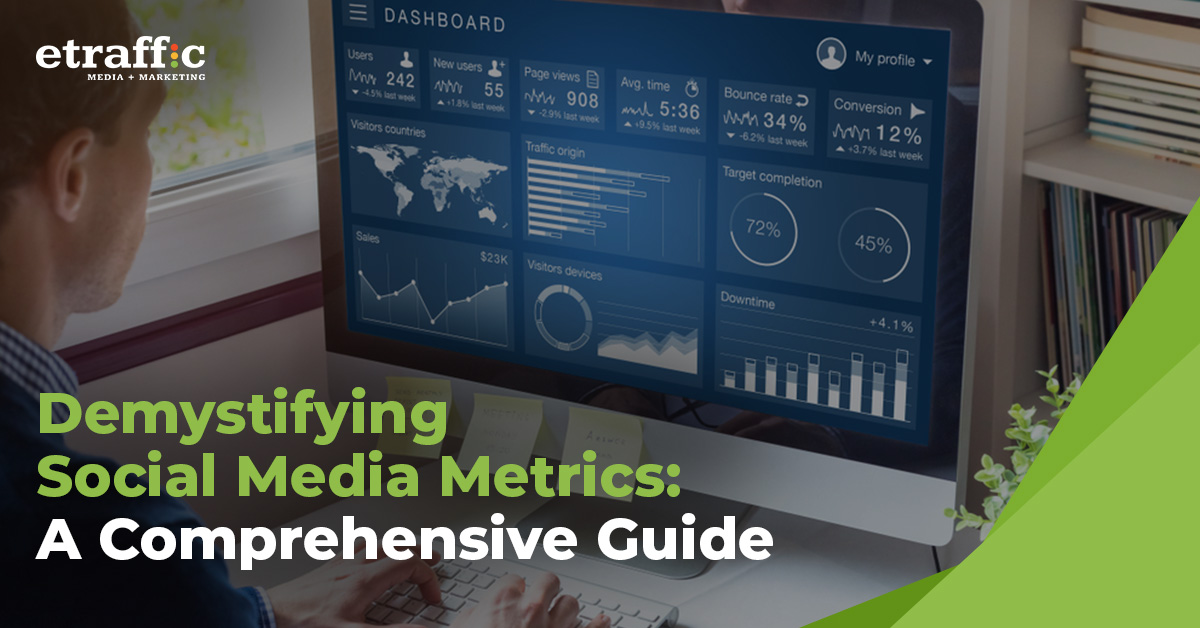![]() Posted by Cameron Francis
on
17 Nov , 2023
in
News
Posted by Cameron Francis
on
17 Nov , 2023
in
News

In the ever-evolving landscape of digital marketing, understanding the nuances of social media metrics is not just an option; it’s a necessity. From Facebook to Instagram, Twitter to LinkedIn, these platforms offer a treasure trove of data that, when deciphered correctly, can be a game-changer for businesses. Social media optimisation is the key to unlocking this potential, ensuring that your online presence is not only present but strategically tailored for success.
So, buckle up as we demystify the world of social media metrics, explore key performance indicators, delve into social media optimisation, and unveil the tools and strategies that can catapult your business into the realm of digital success.
In the dynamic realm of digital marketing, understanding social media metrics is akin to having a compass in uncharted waters. Let’s embark on a journey to demystify these metrics, exploring their definition, significance, and the commonly used indicators that shape the digital landscape.
Social media metrics are the quantitative and qualitative measures used to gauge the performance and impact of content on various social media platforms. They provide insights into how audiences engage with your content, helping you refine and optimise your digital strategy.
The significance of social media metrics lies in their ability to unveil valuable information about your audience, content effectiveness, and overall online presence. These metrics empower businesses to make informed decisions, tailor content to audience preferences, and ultimately drive success in the digital space.
Navigating the vast sea of social media metrics can be overwhelming. Let’s break down the commonly used indicators that provide a snapshot of your digital performance.
Engagement Rate is the pulse of your digital interaction. It is the percentage of your potential audience actively engaging with your content. Calculated as [(Engagements/Reach) x 100], this metric provides insights into the level of participation and connection your content generates.
Likes, Comments, and Shares are the currency of engagement. They signify the depth of interaction and audience response to your content.
Reach is your digital guest list, representing the unique users who have encountered your content. Impressions, on the other hand, are the total views, including repeated ones. Together, they paint a comprehensive picture of your content’s visibility and impact.
How to Leverage Reach for Brand Visibility:
Leveraging Reach is a strategic dance of content distribution aimed at maximising unique views and enhancing brand visibility. Here’s how you can do it:
Understanding Conversion Rate:
Conversion Rate is the compass guiding you from engagement to action. It measures the percentage of users who take a desired action, such as making a purchase, signing up for a newsletter, or filling out a form, compared to the total number of users who interacted with your content.
In simpler terms, it’s the effectiveness gauge – telling you how many of your audience not only engaged with your content but also took the next step you wanted them to take. A high conversion rate indicates that your content is not only capturing attention but compelling users to act on it.
Linking Conversions to Business Goals:
Understanding Conversions is more than just a digital metric; it’s about aligning your online efforts with broader business objectives. By linking conversions to business goals, you transform digital engagement into tangible outcomes.
Increasing Sales: For an e-commerce platform, a conversion might mean a completed purchase. Monitoring this metric helps gauge the success of your sales funnel and optimise for better outcomes.
Generating Leads: If your goal is lead generation, conversions could be measured through sign-ups or downloads. This insight helps refine your lead generation strategy for maximum impact.
Boosting Sign-Ups or Subscriptions: For services or subscription-based models, conversions may represent users signing up or subscribing. It’s a direct link between your digital efforts and the growth of your user base.

Let’s delve into a more detailed exploration with a step-by-step guide that goes beyond the surface, offering a comprehensive understanding of how to navigate and harness the power of social media analytics effectively.
Step 1: Access Your Analytics Dashboard
The journey begins by entering the realm of your social media platform’s analytics dashboard. This is not just a dashboard; it’s your command center, providing detailed insights into the performance metrics that shape your digital narrative.
Step 2: Explore Audience Demographics
As you embark on this analytics expedition, the demographics section becomes your compass. Here, you unravel the composition of your audience—details like age, gender, location, and interests. This demographic snapshot lays the foundation for tailoring content to meet the unique preferences of your diverse audience.
Step 3: Analyse Engagement Metrics
Engagement metrics are the heartbeat of your digital presence. Dive deep into the likes, comments, and shares, dissecting patterns and deciphering which content resonates most profoundly with your audience. This is where the narrative of your brand unfolds through the lens of digital interaction.
Step 4: Evaluate Reach and Impressions
The landscape widens as you scrutinise the data on reach and impressions. This isn’t just about numbers; it’s about understanding how far your content travels and how frequently it makes an impact. Reach and impressions paint the canvas of your digital visibility.
Step 5: Monitor Click-Through Rate (CTR)
In the digital journey, clicks are the currency of action. Keep a vigilant eye on the click-through rate (CTR), especially if your goal is to guide your audience to specific destinations, such as your website or landing page. CTR is the bridge between engagement and tangible action.
Step 6: Identify High-Performing Content
Your expedition takes an exciting turn as you identify high-performing content—pieces that not only capture attention but spark meaningful interactions. Recognising and analysing this content provides the blueprint for future success.
Step 7: Refine Content Strategy
The navigation becomes dynamic as you use analytics to refine your content strategy. Adjust posting times, experiment with content formats, and fine-tune themes based on the ebb and flow of audience engagement. This continuous refinement ensures your content remains a relevant and resonant force in the digital realm.
Step 8: Experiment with A/B Testing
The journey becomes an experiment as you embark on A/B testing adventures. Explore variations in captions, visuals, or posting times to unlock the secrets of what truly captivates your audience. This experimentation is the alchemy that transforms content into gold.
Step 9: Set Benchmarks and Goals
The voyage gains purpose as you set benchmarks and goals based on historical data. These benchmarks become guiding stars, steering your ship towards improvement and ensuring your content strategy aligns seamlessly with overarching objectives.
Step 10: Adapt to Emerging Trends
The horizon broadens as you stay agile and adapt to emerging trends. Analytics become your compass in navigating the ever-changing currents of digital preferences. This adaptability ensures your content remains not just relevant but a trendsetter in the digital landscape.
Overview: Google Analytics stands as a cornerstone in the analytics realm, offering a robust suite for tracking website and social media performance.
Key Features:
Pros:
Cons:
Overview: Tailored specifically for Facebook, Insights provides a comprehensive look into your page’s performance and audience engagement.
Key Features:
Pros:
Cons:
Overview: Instagram’s native analytics tool offers valuable insights tailored for businesses on the platform.
Key Features:
Pros:
Cons:
Limited to Instagram insights.
Social media metrics serve as powerful indicators, illuminating the path to success. They empower businesses to make informed decisions, adapt to evolving trends, and craft strategies that resonate with their audience. ETRAFFIC stands as a guiding beacon in this realm, ready to assist businesses in unlocking the full potential of their social media marketing campaigns.
As a partner in success, ETRAFFIC brings expertise in data-driven strategies, ensuring that businesses not only navigate the digital landscape effectively but also thrive in it. The era of social media success is marked by strategic decisions fueled by insightful metrics, and ETRAFFIC is poised to be your ally on this transformative journey.
Please call us at ETRAFFIC today at 1300 887 151 or book a free strategy session below.
BOOK A FREE STRATEGY SESSION TODAY